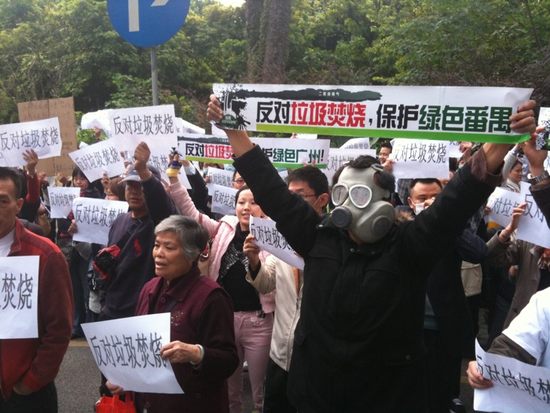Last Thursday, in a press conference the Chinese premier Wen promised a 40% carbon emissions cut by 2020 as a measure to deal with climate change. Facing suspicion and questions, he reiterated the next day in a meeting with developing countries that it was a ‘serious and solemn promise’. But no one could fail to see how far China still has to go to curb its pollution and increasing energy consumption.
In October, Lu Guang, a Chinese photographer, was awarded the Eugene Smith grant, an international award for Humanistic Photography for his pictures documenting pollution in China. For foreigners, these pictures might be just another warning of the world of the environmental degradation happening in China. But for most Chinese, it was shocking in the extreme to see those familiar places, often seen on books and maps or heard from families and friends, now as dead zones unfit for human habitation.
So, what then will be the determining factors in the fight against the deteriorating environment of China?
Not necessarily the government. Compared to environment improvement, it has a stronger incentive in economic development and political achievement. As example, last week was difficult for people living in Guangzhou, the capital of Guangdong province and one of the richest areas in China. People were appalled to find they were almost blinded by haze and fog, generated by car exhausts, construction site activity and power plant emissions. Highways were shut down because drivers could not see cars over 5 meters away. It is the most serious atmospheric pollution day in the last 10 years.
GV Blogger John Kennedy living in Guangzhou described the city as being ‘just like a huge construction site full of traffic jams.’
There is a reason for this huge burst of activity. To prepare for the 2010 Asian games, Guangzhou is being fully mobilized to build simultaneously 8 subway routes and a satellite city of stadiums and residences for the sportsmen, This political imperative takes precedence over all else.
Last Monday, again in Guangzhou, hundreds of residents waited anxiously outside a newly established office which processes complaints and appeals about plans to build several garbage incinerators which may be as close as 1000 meters to their homes. They fear that the resultant pollution will inevitably result in cancers and other diseases

Initially it was peaceful and people followed the procedure to fill in forms and line up but they finally became impatient when only 10 of the hundreds of complaints were received in a 2 hour period. Bloggers twittered about what happened there next.
@wenyunchao 来了辆警车停路边,一分钟后开走了。见到几个本地记者。陆续有人赶来,不过看似丽江的居多。有个人举着标语站到了解放路边,直接向民众诉求。 #pylj
@LEMONed
粗略点算,还在门外排队的就有超过两百人,还不断有人加入。但城管委已经不让再领表了!有来自南国奥园的业主高呼「吕秘书长下台!」 #pylj
“广州未来将走垃圾焚烧为主的路子,肯定要建垃圾焚烧发电厂,建几个,政府正在规划” 。
The remarks were seen as blind ignorance of the public opposition when in fact, residents had voiced their objections on the internet for months. The plan was revealed as early as 2006 but only in 2009 were the sites confirmed and land use permits issued. People were shocked to find that the view out of their windows in the future would be dominated by the incinerators. Property values soon slumped.
Back to the scene.
@wenyunchao 现场人士举起标语走向旁边的市政府,接访演变成游行及集会,我们将继续为大家直播。 #pylj
wenyunchao 人群已经聚焦在市政府门口,头顶上A4纸复印的标语白花花一片,有个81岁的会江村婆婆也为了,现场口号”市长出来”。 #pylj
@wenyunchao 群情比较激愤,一位会江村民说:我少活二十年也就忍了,可子孙们怎么办?吉祥路这一侧停了六部警车,不过秩序尚好。 #pylj
@LEMONed 喇叭广播说让这里几百人选5名代表进去见领导,这是想把我们先打乱!广州人民这么容易上当?我们随即齐声回应:「选5名领导出来」!警察顿时傻了 #pylj
Weng YunChao, on twitter and also a well-known blogger, comments on the scene:
@wenyunchao 这是未来国内群体运动很有代表性的问题,政府要对话,必须得有民众代表,但民众代表往往成为打击对象,政府往往找不到对话对象。事情往往因此而走向僵局。 #pylj
The indifference of the government and reluctance to talk with people is even a more serious problem than the pollution itself. An article by by Xinkuan Paper states:-
从省情调研中心发布的民调数据来看,超过98%的民众对“涉及众多民众利益,但有关部门垄断行政决策,未能及时通报消息”最为不满———这一对周边环境及 民众生活可能产生重大影响的项目,从2004年确定地址、2006年通过审批、2009年开始征地,5年中没有情况通报,没有听证,甚至电厂所在的会江村 村民也大多不知道有该项目的存在,直至它突兀地被民众关注。
There has been much controversy on the issue. Is incineration the best method to dispose of the mountains of trash? If the incinerators are not built at these places, where then should they be built? Again, John Kennedy has a coverage on the debate.
The government has made (9) two clear points. First, if the project gets stuck in an environmental assessment, it won’t be carried out. Second, if the majority opposes it, it will also be stopped. But it is left to doubt that it would.
However, distrust of ‘expert assessment’ prevails as experts are losing their creditability as people think they are puppets of power and money. Second, people see little sincerity on the part of the government to consider public opinion as in the past four years it made no attempt at a dialogue. Moreover, the residents have no idea whether they can keep fighting the authority if attention on the issue dies down. Luckily, the demonstration on Monday ended peacefully although no one knows if there will be any act of reprisal or whether their complaints will have any effect.







1 comment